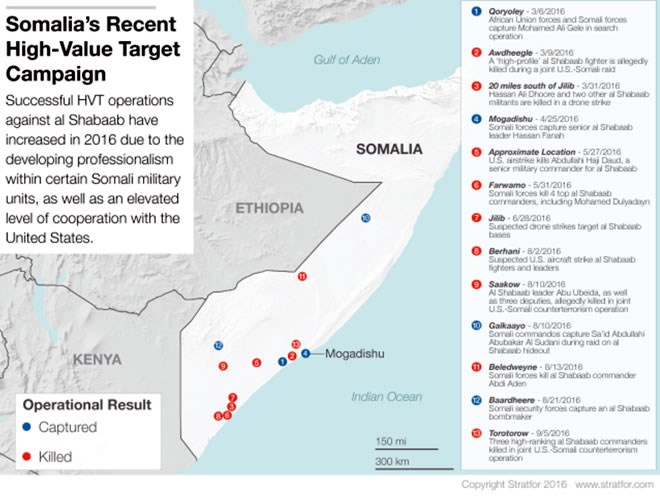
Friday, September 9, 2016
Increasing professionalism among Somali security forces has enabled them to strike high-value targets in the Islamist al Shabaab militia with greater frequency. Still, there are limits to what these kinds of operations can achieve. (MOHAMED ABDIWAHAB/AFP/Getty Images)
The campaign against Somali Islamist militia al Shabaab has taken a turn this year. Thanks to increasing professionalism among some units of the Somali military, which has led to better intelligence operations and heightened cooperation with U.S. special operations forces, strikes have occurred more frequently against high-value targets (HVTs) in al Shabaab. But despite the security forces' recent successes, the Islamist group still poses a significant security threat. Not only does it continue to launch terrorist attacks in Mogadishu and beyond, but it also regularly amasses forces capable of chasing Somali army and African Union troops from their positions in southern Somalia.
The tactic of targeting al Shabaab's leaders dates back years. The United States has been a key actor in these targeted attacks since the beginning of the Somali civil war, when U.S. troops attempted to hunt down important members of the clan militia loyal to self-proclaimed president Mohamed Farrah Aidid. The hunt led to the infamous Battle of Mogadishu in October 1993, which left 18 U.S. soldiers dead and is widely seen as the United States' main reason for disappearing from the Somali theater until 2007.
A New Era for the Somali Military
The recent uptick in HVT attacks in Somalia signals an important evolution in the skill of the Somali military. Throughout the Somali civil war, which started three decades ago with the fall of President Mohamed Siad Barre, the capabilities of the country's armed forces were severely degraded. Despite training initiatives and external financing, most of the Somali military continues to perform poorly and remains divided along political and clan lines. Some isolated units have received dedicated attention, however, and have achieved positive results. For example, the Gaashan special operations unit — better known by its Alpha Group and Bravo Group designations — has undergone professional training with help from foreign powers and private military corporations. The unit, which focuses on counterterrorism, particularly in and around Mogadishu, has gotten better at protecting government officials and facilities.

Another elite Somali army unit, the Danab special operations force, is closely linked with the recent HVT attacks across the country. Danab is modeled after a U.S. Army Ranger regiment whose primary objectives include HVT operations. U.S. special operations forces, which trained Danab's members, have also joined the unit for the bulk of the intensified HVT campaign. Reports suggest that in some cases the Somali units carried the weight of the operations, while U.S. forces were limited to advisory and support roles.
Along with these newly trained and well-equipped units, the Somali armed forces have adopted practices that have facilitated HVT operations. As al Shabaab leaders are captured or killed, specialized units have been able to gather intelligence using a counterterrorism technique known as site exploitation, enabling the army not only to more effectively fight the group in general but also to target more of its leadership. Interrogations of captured al Shabaab leaders provide similar intelligence, and the combination of these sources has led to even greater success against the militia. However, the overall impact of these operations is still limited. Even though the professionalized Somali units provide points of contact that external forces can work with or through, they are still relatively few in number and can only conduct so many operations.
A Limited Tactic
There are also limits to what the HVT campaign can achieve. The death or capture of key personnel can disrupt al Shabaab operations and force the militia's leaders to take security measures that reduce their effectiveness. Many al Shabaab leaders recently have gone to ground, sacrificing mobility and restricting their public appearances or direct interaction with other elements of the militant group. But at the same time, the campaign has not stopped lower-level members of al Shabaab from conducting attacks against civilian targets and government forces. Those initiatives, along with broader sets of directives from the group's leadership, are still enough to sustain al Shabaab's operations.
Despite the pressures of the HVT campaign, al Shabaab has shown that it remains capable of conducting significant attacks. Recent bombings in Mogadishu employing powerful vehicle-borne improvised explosive devices followed near-simultaneous bombings in Galkaayo, to the northeast of the capital, and Baardheere, to its west. The HVT campaign could have spurred the latter attacks: Somali forces had recently captured a bombmaker in Baardheere and a foreign fighter in Galkaayo. The bombings in those cities were likely carried out in retaliation for the arrests.
Besides its terrorist activity, al Shabaab has also continued to pressure Somali and African Union forces garrisoned throughout southern Somalia. The militant group has launched raids on their bases that have frequently forced African Union and Somali troops to retreat. The HVT campaign cannot be expected to put a stop to these capabilities, although it will continue to disrupt the planning for such operations and their well-coordinated execution.